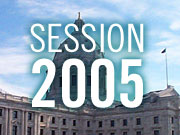More from MPR
| ||||||||||||||||||||||||||||||||
July 14, 2005
St. Paul, Minn. — Here's a summary of the major elements of the Minnesota state budget for the 2006-07 biennium.
THE TOTAL PACKAGE:
The cost of the 2006-07 budget to the state treasury is $30.5 billion, up from about $28.2 billion in the previous two-year spending plan. The additional $2.3 billion translates into an 8.4 percent increase.
If no state policies had changed this year, the state would have spent $30.2 billion to provide the same level of services.
Of the general fund spending, approximately 41 percent will go
to education, 27 percent to health and human services programs, 9.8
percent to tax credits and local aids, 9 percent to higher
education, 5.5 percent to public safety and the rest spread over
smaller categories.
EDUCATION:
-Roughly $12.6 billion will go to K-12 and early childhood
education programs over the next two years.
-The general per-student allowance available to all public
schools will climb 4 percent each year, raising it to $4,974 by the
2006-07 school year.
-Statewide, school districts will be authorized to seek local
property tax increases of up to $139 million next year. It can go
for classroom extras, school safety measures, and facility needs,
among other things.
-School districts that agree to change their teacher pay
packages to award raises more on merit than seniority will get to
draw from a $78 million pool of incentive funding and get more
local levy authority to supplement the state dollars.
-High school students who want to get a jump on college will get
more state assistance, through an $11.6 million program that will
help them pay for college-level courses and exam fees.
-About $11 million more will go to programs for gifted and
talented students.
-Funding for special education programs will increase by $23
million.
HEALTH AND WELFARE:
-The state's cost for these programs adds up to $9 billion for
the next two years.
-The Tobacco Health Impact Fee adds a wholesale charge of 75
cents per pack of cigarettes and doubles the wholesale fee for
cigars, snuff and other tobacco products, raising about $400
million over the next two years.
-MinnesotaCare remains available to those who currently qualify.
The bill repeals a $5,000 yearly limit on outpatient benefits and a
$500 cap on dental services. Diabetics shouldn't run into limits on
coverage of test strips and insulin equipment. Medical Assistance
recipients will get lower copayments for drugs.
-Nursing homes will get back-to-back 2.6 percent bumps in state
funding.
-People with disabilities will have more access to programs and
funding to help them move out of institutions and live
independently. Parents of disabled children will see lower fees for
state-supported medical services.
-Abortion opponents got two of their priorities - a provision
that encourages the use of anesthesia for the fetus during an
abortion, and a reduction in family planning grants by $1.9 million
a year starting in 2007.
TAX BILL:
-A $44 million increase in aid to local governments, which will
help them cover costs for services such as police and fire
departments and libraries.
-$57 million in new revenue from stricter regulation of tax
shelters.
-$19 million from extending a 12.7-percent rental car sales tax
that was due to expire.
-$39 million from requiring up-front payments of sales tax on
leased cars.
-An additional $4 million for cities with populations under
5,000.
-Grants the cities of Rochester, Albert Lea, Bemidji, Willmar,
Winona, Worthington, and St. Cloud and several of its smaller
neighbors authorization to ask voters for sales tax increases to
pay for local projects.
-Exempts in-state National Guard income from taxation. Also
subtracts active duty military pay out of state from the income
tax.
-Grants an income tax deduction on personal contributions to
Health Savings Accounts, allowing tax-free saving for medical
expenses.
-Firms up the definition of foreign operating corporations for
the purpose of tax exemptions in state law, to ensure that such
businesses do most of their business outside the U.S.
-Provides a sales tax exemption for ready-to-eat meat and
seafood.
-Repeals the family cap of $2,000 for the K-12 education credit.
-Extends the $250 tax deduction for teachers who purchase
classroom materials.
-Provides an income tax credit for organ donation.
-Places a one-year freeze on the taconite production tax.
(Copyright 2005 by The Associated Press. All Rights Reserved.)




